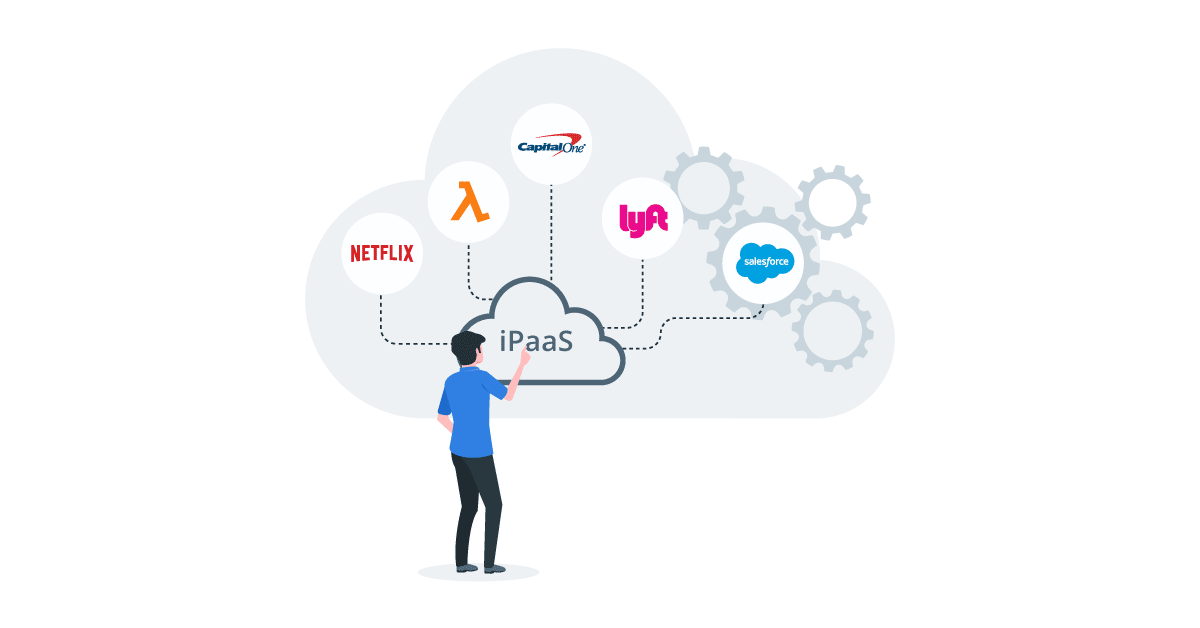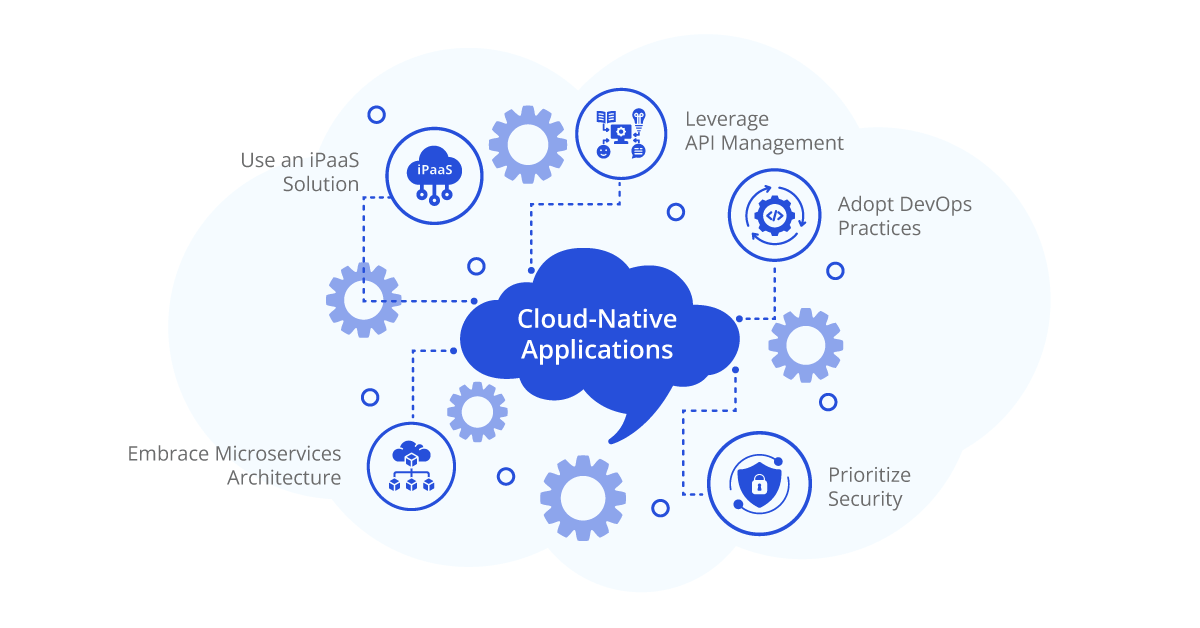As businesses continue to shift towards cloud-based solutions, integrating applications, data, and processes across multiple cloud services has become a priority. Cloud-native technologies provide a range of tools and platforms designed to make application integration in a cloud environment easy and efficient.
With cloud-native technologies, applications can be integrated seamlessly across various cloud services like Amazon Web Services, Microsoft Azure, and Google Cloud Platform. Containerized applications can be built and deployed on multiple cloud services, allowing businesses to benefit from the services of each cloud provider.
Deploying and managing applications across multiple cloud services is made possible by cloud-native technologies, allowing businesses to quickly scale up applications to meet increasing demand. They also provide the ability to connect applications and data across different cloud providers, increasing efficiency and lowering costs.
By leveraging cloud-native technologies, businesses can rapidly move their applications and data to the cloud, taking advantage of the cloud’s scalability and flexibility. Additionally, these technologies facilitate the integration of applications, data, and processes across multiple cloud services, allowing businesses to optimize their cloud investments.
Aonflow iPaaS – Free for First 3 Months!
Build and run up to 1,500 transactions monthly with no cost. No payment info needed!
Understanding Cloud-Native Integration
Cloud-native integration is a software development approach that utilizes cloud computing technologies to build, deploy, and manage applications in a highly scalable, agile, and cost-effective way. This approach is focused on designing applications to run on the cloud, rather than just moving existing applications to the cloud.
At the core of cloud-native integration is the use of microservices architecture, which involves breaking down large, monolithic applications into smaller, more manageable services. These services are then deployed and run in containers, which are lightweight, portable, and can be easily scaled up or down based on demand.
Cloud-native integration also relies on the use of DevOps practices, which involve automating the software development, testing, and deployment process. This approach allows developers to rapidly and continuously deploy new features and updates to applications while ensuring high levels of reliability, security, and scalability.
Here are some examples of how cloud-native integration is used in practice:
Amazon Web Services (AWS) Lambda: AWS Lambda is a serverless computing service that enables developers to build and run applications without managing servers. It is an example of cloud-native integration, where developers can build serverless applications by breaking down monolithic applications into smaller, independently deployable microservices.2
Netflix: Netflix is a popular streaming service that has built its platform using cloud-native integration principles. The company uses a combination of AWS and Netflix’s open-source cloud-native platform, Spinnaker, to develop, deploy, and manage its applications. Netflix’s architecture is designed to handle massive traffic loads and provide a seamless user experience.
Capital One: Capital One is a financial services company that has transformed its IT infrastructure using cloud-native integration. The company has built a platform called Critical Stack that leverages Kubernetes and other cloud-native technologies to build, deploy, and manage applications in a scalable, secure, and compliant way. Critical Stack provides developers with a self-service platform to build and deploy applications.
Lyft: Lyft, a ride-sharing company, has built its platform using cloud-native integration principles. The company’s architecture is based on microservices and containerization, enabling developers to build, deploy, and manage applications in a scalable, flexible, and cost-effective manner. Lyft uses AWS and Google Cloud Platform to host its services.
Salesforce: Salesforce is a customer relationship management (CRM) platform that has built its platform using cloud-native integration. The company has developed a platform called Heroku, which enables developers to build, deploy, and manage applications using a variety of programming languages and frameworks. Heroku also integrates with a range of cloud services, including AWS, Google Cloud Platform, and Salesforce’s cloud services.
Cloud-native Applications Integration Best Practices
As cloud-native technology continues to grow, more organizations are realizing the importance of developing and deploying cloud-native integration solutions. Successful cloud-native integration can lead to optimized IT operations, reduced costs, and faster development and delivery times. Here are some best practices for achieving successful cloud-native integration:
Develop a Comprehensive Strategy: The first step in implementing a cloud-native integration solution is to create a comprehensive strategy that identifies and prioritizes the integration needs of the organization. The strategy should also include a timeline for implementation.
Use Reusable Components: Utilizing reusable components can save time and reduce costs when deploying cloud-native integration solutions. By using existing components, organizations can minimize the amount of code that needs to be written and tested.
Automate Processes: Automation is a crucial element of successful cloud-native integration. Automation tools can automate tasks such as testing, deployment, and monitoring, which can save time and reduce errors.
Incorporate Containers: Containers are an essential tool for cloud-native integration. Containers package applications and their necessary components into a self-contained, isolated environment, which makes them ideal for running integration solutions in the cloud.
Monitor Performance: Continuous monitoring is essential for maintaining the optimal performance of a cloud-native integration solution. Organizations should regularly monitor the solution for potential issues and address them quickly.
Implementing these best practices can help organizations achieve a successful cloud-native integration solution that is optimized for performance, cost-effective, and efficient.
Building Cloud-native Applications With iPaaS
Building cloud-native applications with iPaaS (Integration Platform as a Service) is a popular approach that can help businesses create modern and scalable applications that can easily integrate with other systems and services in the cloud.
iPaaS solutions offer pre-built connectors and tools that enable businesses to connect their applications with popular cloud services such as AWS, Azure, and Google Cloud, as well as with on-premises systems. This makes it easier to develop and deploy applications without worrying about the underlying infrastructure and integration challenges.
Additionally, iPaaS solutions offer a wide range of features that can help businesses build cloud-native applications with ease. These features include workflow automation, real-time data processing, API management, and more. This makes it easier to create modern, cloud-native applications that are designed to scale and adapt to changing business needs.
One of the key advantages of using iPaaS for building cloud-native applications is the ability to leverage pre-built components and connectors. This can help businesses save time and reduce costs by avoiding the need to build and test custom integration solutions. Instead, they can rely on pre-built components that have already been tested and optimized for performance and scalability.
Another advantage of using iPaaS for building cloud-native applications is the ability to focus on application development rather than infrastructure management. With iPaaS, businesses can focus on developing applications that meet their specific needs, while the platform handles the underlying infrastructure and integration challenges.
Building cloud-native applications with iPaaS offers many benefits, including faster time-to-market, lower costs, and simplified integration. By leveraging pre-built components and connectors, businesses can build modern, scalable applications that can easily integrate with other systems and services in the cloud.
Aonflow is the leading integration platform.
You can kick-start by integrating your first-ever workflow in just a matter of minutes.
Scaling Cloud-native Applications With iPaaS
Scaling cloud-native applications is an important consideration for organizations looking to leverage the benefits of cloud-native technologies. One solution to achieve scalability is by using an integration platform as a service (iPaaS) solution. iPaaS can help organizations rapidly scale their cloud-native applications by providing a centralized platform for managing and integrating their applications and services.
iPaaS solutions offer several benefits for scaling cloud-native applications. One of the key benefits is that they provide a unified platform for integrating multiple applications and services. This makes it easier to manage the complexity of cloud-native applications and ensures that data is flowing seamlessly between services.
Another benefit of using iPaaS for scaling cloud-native applications is that they provide a scalable architecture. These solutions are designed to handle large volumes of data and users, making them ideal for organizations that need to rapidly scale their applications in response to changing business needs.
iPaaS solutions also provide a high level of automation, which helps organizations to scale their applications more easily. Automation tools can help manage tasks such as testing, deployment, and monitoring, which can reduce the time and effort required to scale cloud-native applications.
In addition to these benefits, iPaaS solutions provide several other features that can help organizations scale their cloud-native applications. For example, they often provide pre-built connectors for popular cloud services, making it easier to integrate with these services. They may also provide tools for data transformation and mapping, which can help organizations to manage the complexity of data integration in a cloud-native environment.
iPaaS solutions offer a powerful platform for scaling cloud-native applications. By providing a centralized platform for managing and integrating applications and services, these solutions can help organizations rapidly scale their applications in response to changing business needs.
Cloud-Native Applications Integration Strategies for Enterprises
As enterprises move towards the cloud, cloud-native applications integration has become a crucial part of their IT strategy. By combining various cloud-based services with legacy systems, enterprises can create a unified experience for their users. However, this can also be a complex process, requiring careful planning and execution. Here are some cloud-native application integration strategies that enterprises can adopt:
Use an iPaaS Solution: Integration Platform as a Service (iPaaS) solutions provide a unified platform to connect multiple cloud-based applications and services. This allows enterprises to manage data security, scalability and costs more easily. With iPaaS, enterprises can connect different systems and applications without the need for complex custom coding.
Leverage API Management: Enterprises can use API management solutions to secure and govern access to cloud-based services and applications. This helps to ensure data privacy and compliance, while also providing greater visibility and control over the enterprise’s cloud environment.
Embrace Microservices Architecture: Microservices architecture breaks down large, monolithic applications into smaller, more manageable services that can be independently deployed and scaled. This makes it easier to integrate multiple cloud-based services and applications, as well as manage performance and scalability.
Adopt DevOps Practices: DevOps practices can help enterprises rapidly deploy and update cloud-based applications and services. This can include continuous integration and deployment (CI/CD) pipelines, automated testing, and infrastructure as code (IAC) practices.
Prioritize Security: Security should be a top priority when integrating cloud-native applications. Enterprises should ensure that all data is securely stored and transmitted, and that access is restricted to authorized personnel only. They should also prioritize security during the development and deployment of cloud-based applications and services.
By adopting these cloud-native application integration strategies, enterprises can better manage the complexities of integrating cloud-based services and applications. This can help them to improve performance, reduce costs, and enhance the user experience.
Securing Cloud-native Applications With iPaaS
As cloud-native applications become increasingly prevalent, security concerns become more pressing. Organizations must ensure that their applications are secure and that sensitive data is protected from unauthorized access. By leveraging iPaaS solutions, organizations can take advantage of built-in security features to secure their cloud-native applications. With features such as data encryption, identity and access management, and network security, iPaaS solutions can help organizations mitigate the risks associated with cloud-native applications and ensure the security and privacy of their data. Organizations must prioritize security in their cloud-native integration strategies to ensure the success and longevity of their applications in today’s digital landscape.
Aonflow iPaaS – Free for First 3 Months!
Build and run up to 1,500 transactions monthly with no cost. No payment info needed!


